SSC Stylus
Better than a Caterham? Graham Bell takes a look
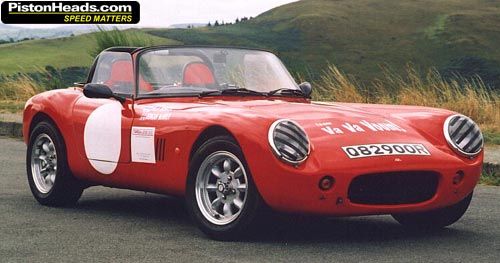
Take a Caterham 7 and clothe it in a curvy full-width body offering better aerodynamics, increased passenger comfort and secure luggage space and what have you got? That’s right, a Caterham 21.
However, Caterham aren’t the only - or indeed the first – company to make use of the potential offered by mating a lightweight spaceframe roadster chassis to a lightweight wind-cheating body. Ginetta did it to great effect back in the 1960s with the G4, which later spawned the G27, while the concept has also been used very successfully by Jeremy Phillips of Sylva.
Chances are most PH readers haven’t heard of Jeremy Phillips, but his cars regularly beat the Caterfields in kit car racing, winning the 750MC kit car series nine times in 12 years. The car featured here uses chassis developed from a championship winning car.
Phoenix, Fury, Stylus
Evolved from a narrow-bodied 7 style roadster called the Sylva Striker by way of full bodied variants called the Phoenix and Fury - all of which have successful competition histories - the Stylus was designed to provide a more practical road-biased alternative with more interior space and a boot lid.
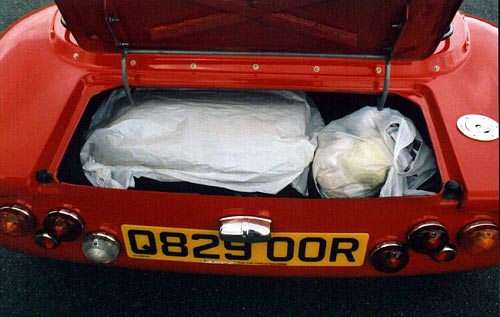
Room for a few cauliflowers and a crate of beer
Now as you’ll have noticed, the title says SSC Stylus, not Sylva Stylus. That’s because in 1996 production rights were sold to long time car nut and one time Fury builder Peter Powell, who found himself faced with early retirement just as the rights went up for sale, with the result that Specialist Sports Cars was born.
When Peter took on the Stylus it was designed to use mechanical parts from a Mk 2 Escort, but with these becoming ever harder to find, SSC have since developed it to take more modern parts and were one of the first kit car companies to fit the Zetec engine.
Zetec Power
The venerable X-flow is still an option, but these days Zetecs or 16-valve Vauxhall engines tend to be the power units of choice, though various other twin cams have been fitted, as has the Rover V8! Not surprisingly, the lightweight nature of the Stylus also makes it suitable for bike engines too, though SSC don’t rate them for road use.
For rear suspension the Stylus originally used the Escort’s live axle, located by leading upper and trailing lower arms plus a Panhard rod, with adjustable coilover dampers mounted to the lower arms just ahead of the axle. SSC’s newer alternative is a De Dion axle using the diff and narrowed drive shafts from a Sierra. Like the live axle this too uses leading upper and trailing lower arms (the same ones in fact) but has a Watts linkage rather than a Panhard rod.
However, the live axle still remains a popular choice, especially with the competition crowd, mainly due to the wider range of diffs available, though they tend to ditch the drum brakes in favour of SSC’s disc conversion.
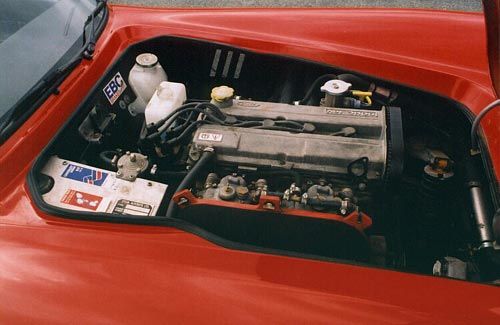
And bigger, better brakes are why most people choose the newer Sierra based suspension over the original Escort option for the front. Actually, in either case the majority of the fully adjustable set-up is custom made, comprising lower wishbones with upper rocker arms linked to vertical inboard coilover units, with the only real difference being the use of Sierra stub axles as opposed to ones made from cut down Escort struts.
Not all the changes SSC have made to the Stylus’ suspension have been to accommodate newer parts though, because they decided that while Jeremy Phillip’s original set-up was undoubtedly very good, it could nonetheless be improved upon. Consequently, most of the original Metalastic bushes have been replaced by urethane ones while the rocker arms now pivot on needle roller bearings rather than nylon bushes, resulting in more positive location and feedback without in any way adversely affecting that race-proven handling.
Style
But – as has been covered at length on PH before in respect of certain other cars – it’s not much good having a car with superb handling if people are put off by the styling. Well that’s not likely with the Stylus, which has an attractive 1960s look, and aesthetically the only thing about it that generally grates is the hotch-potch of individual light units on the back of the demonstrator. This might be the easy way to satisfy legal requirements but it’s hardly stylish, so many owners opt for more work setting in multi-function units which produces an altogether neater looking back end. Some people aren’t keen on the demonstrator’s Porsche 356 style headlamp covers either, preferring the optional 1960’s race style Perspex bubble fairings instead.
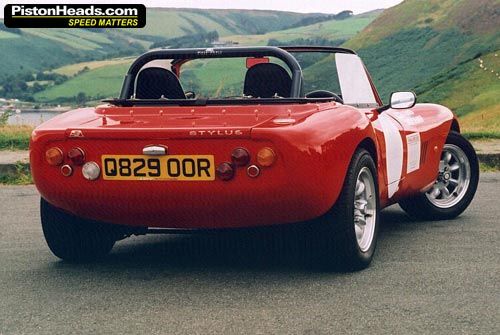
On the subject of race style, you can’t fail to have noticed that the demonstrator sports door roundels and other markings indicating that that it sees some competition use - which it does, in the form of both road rallies and hillclimbs. Add to that the fact that the demonstrator is now six years old, and it should come as no surprise to learn that it’s rather tatty around the edges, but overall it seems to be standing up to all the use and abuse quite well which says a lot about the basic integrity of the engineering.
Mechanically the demonstrator uses a disc braked live axle, Escort derived front uprights and a Webered 1800cc Zetec engine producing around 145bhp, so it’s not particularly powerful – but then of course lightweight sportscars don’t need to be. Just how lightweight is the Stylus? That obviously depends on the engine etc, but a normal car-engined ‘road spec’ Stylus will tip the scales around the 625kg mark. With the optional lightweight chassis and body and a bike engine it’ll be nearer 425kg. Now that’s light.
Creature Comforts
The reason for the modest power output is that the demonstrator was originally built as a pure road car rather than for competition use, which also explains why you’ll find both a heater and SSC’s full if understandably rather basic trim package fitted to the interior. Entry to this through the small doors isn’t too difficult, at least with the hood off, and though the racing seats currently fitted to the demonstrator definitely favour those of slim build, there is enough width in the cockpit to accommodate those of slightly broader stature providing wider bum perches are used.
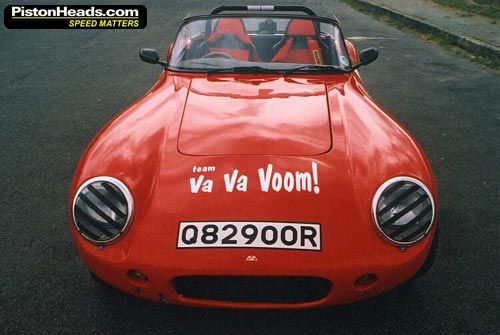
Typically for this type of car, driving position is of the low slung straight leg variety with pedals mounted straight ahead, and while foot room is more generous than in a 7 narrow footwear is still advisable.
At the time of testing the car was set up for hillclimbing so had firm suspension settings, and while this did it no favours over bumps around town it certainly paid dividends along the twisty undulating roads that SSC’s mid-Wales base is surrounded by.
Handling
The Stylus’ body control and composure through the corners was excellent, with a marked lack of perceptible roll despite the absence of anti-roll bars and surefooted grip from the 185/60x14 Yokohama A539s adding up to a confidence inspiring package. A very communicative one too thanks those urethane bushes and the back axle bouncing up and down just a few inches from your backside. This ‘seat of the pants’ feel combines with the roar of the exhaust and the smell of petrol from the Webers to provide the sort of truly intimate driving involvement that only a lightweight roadster can.
With its low weight and low 4.1:1 gearing, the Stylus built up speed at a very respectable rate (in this state it should do 0-60 in just over 5 seconds and around 125mph) and with a 2.4 turn Escort quick rack providing positive, direct steering that was a joy to use, it felt nimble and responsive along the winding mountain roads.
Sadly my stint behind the wheel was rather brief, but it was great fun, and thanks to those terrific Welsh roads even a short run was enough to confirm that the Stylus has all the right ingredients to satisfy a true sports car enthusiast.
It’s also amusing to note that a 200bhp Zetec powered Stylus owned by the former series director of Channel 4’s Driven posted the quickest overall time through their handling course, but typically the powers that be wouldn’t let him cover it on the programme. Well, it wouldn’t do to have some kit car made with old Ford bits showing up those awfully nice Porsches now would it?
Costs
SSC say it’s possible to build a bargain basement X-Flow powered Stylus for under £6,000, with £8-9,000 being more typical for a home built Zetec powered car of similar spec. to the demonstrator.
But if you rate outright performance as more important than comfort or practicality then you’ll want the latest Stylus RT with revised bodywork, cut down screen, front splitter, rear diffuser and wing.
Although sadly not road legal at the time of my visit, SSC’s new RT demonstrator with a 225bhp version of Ford’s four-cylinder Duratec has already proved itself capable of matching Caterham’s R400 on the track, yet can be built for just half the price.
Which means you can enjoy the same high level of performance while still having plenty of money left over for track day fees…
© Copyright Graham Bell 2003
Links
 |
 |
 |
 |
 |
Gassing Station | Kit Cars | Top of Page | What's New | My Stuff



